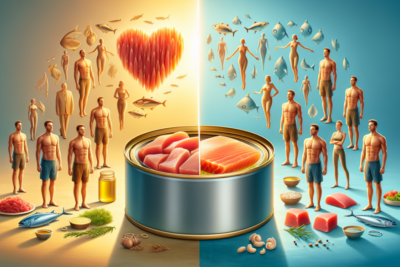
The World Health Organization has raised a red alert: processed and red meat consumption is now under scrutiny. With mounting evidence linking these foods to serious health risks, including cancer, it's time for consumers to take a closer look at their dietary choices.
Understanding the risks associated with red and processed meats can empower individuals to make informed decisions. Let's delve into the specifics of why these meats are causing concern among health experts and explore feasible, healthier alternatives.
🔍 Seeking a breakthrough in Type 2 Diabetes management?
Discover our expert insights and innovative approaches on ‘How to Cure Diabetes’.
Click to transform your health journey today!
What you\'ll find in this article?
- What is red and processed meat?
- How does processed meat cause cancer?
- What is the risk associated with red meat?
- How much red meat should we eat?
- Healthy alternatives to red and processed meat
- Benefits and risks of unprocessed red meat
- Further insights into red meat consumption
- Questions related to the health risks of red and processed meat
What is red and processed meat?
Red meat refers to the meat from mammals, which includes beef, lamb, and pork. Processed meat, on the other hand, has been transformed through curing, salting, smoking, or adding chemical preservatives. This category includes products like bacon, sausages, hot dogs, and deli meats. The convenience and taste of processed meats have made them staples in many diets, but at what cost to our health?
It is important to distinguish between the two as their health implications differ. While both are rich in proteins and essential nutrients, the processing involved in products like sausages or bacon introduces additives and chemicals that can be detrimental to health.
Explore our specialized services in diabetes care 🌟.
From personalized diet plans to effective exercise routines, we have what you need to take control of Type 2 Diabetes.
Visit our services page now!












How does processed meat cause cancer?
Processed meats have been classified by the International Agency for Research on Cancer (IARC) as Group 1, carcinogenic to humans. This categorization is due to the presence of chemicals such as N-nitroso compounds and polycyclic aromatic hydrocarbons, which can form during processing or cooking at high temperatures. These substances have been shown to cause DNA mutations that can lead to the development of cancer cells.
Studies have specifically linked these meats to an increased risk of colorectal cancer. The high levels of preservatives and other chemicals in processed meats are thought to be the main culprits behind this elevated risk. Moreover, the methods of cooking such as barbecuing or frying at high temperatures can also contribute to the formation of harmful compounds.
What is the risk associated with red meat?
Red meat is classified as a Group 2A carcinogen by the IARC, which means it is probably carcinogenic to humans. The association between red meat and cancer, particularly colorectal cancer, is not as strong as with processed meats, but it is still significant. Research indicates that heme iron, the type of iron found abundantly in red meat, may help form N-nitroso compounds in the digestive tract, leading to cancer.
How much red meat should we eat?
While red meat can be part of a balanced diet due to its nutrient content, moderation is key. Current recommendations suggest limiting red meat consumption to no more than two to three servings per week. It's advised that individuals consume lean cuts and try to avoid processed forms altogether to minimize health risks.
Healthy alternatives to red and processed meat
- Opt for lean white meats like chicken or turkey.
- Incorporate plant-based proteins such as beans, lentils, and tofu into your diet.
- Consider fish as a source of healthy fats and proteins.
- Explore meat substitutes that offer similar textures and flavors without the health risks.
Benefits and risks of unprocessed red meat
Unprocessed red meat is a valuable source of nutrients like protein, iron, and B vitamins. However, the key is to choose lean cuts and consume them in moderation. Unprocessed red meat can still contribute to an increased risk of cancer if consumed in large quantities. Thus, balancing its intake with plenty of fruits, vegetables, and whole grains is crucial.
Further insights into red meat consumption
While red meat can be part of a healthy diet, it's essential to consider the frequency and amount of consumption. The World Health Organization suggests moderation in eating red and processed meats, recommending a varied diet that includes more plant-based foods. Such an approach can not only reduce the risk of cancer but also support overall health.
Is red meat the same as processed red meat?
No, red meat refers to muscle meat from mammals, whereas processed red meat includes meat that has undergone preservation or flavor-enhancing processes. The health implications of processed red meat are more concerning due to the added chemicals and preservatives.
Is red meat a cancer warning?
Red meat has been labeled as "probably carcinogenic" by the IARC, especially when consumed in large quantities. The risk is linked to compounds that can form in the meat during certain cooking methods or that are inherently present in red meat.
Is red and processed meat linked to heart disease?
Yes, there is evidence suggesting that high consumption of red and processed meat can increase the risk of heart disease. This is partly due to the saturated fat content, which can contribute to higher levels of cholesterol in the blood.
What is the warning on red meat?
The warning on red meat primarily concerns its potential carcinogenic properties, particularly when it comes to colorectal cancer. Health organizations emphasize moderation and recommend a diverse diet that includes a variety of protein sources.
As we stay vigilant to health alerts such as the red alert: processed and red meat, we must also look to research and expert advice to guide our dietary choices. By exploring healthy alternatives and staying informed, we can navigate the risks and make choices that support our well-being.
✨ Other articles you might be interested in:



